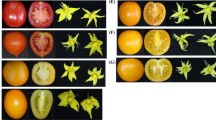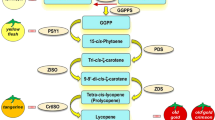Abstract
Key message
We provide multiple evidences that CaGLK2 underlies a quantitative trait locus controlling natural variation in chlorophyll content and immature fruit color of pepper via modulating chloroplast compartment size.
Abstract
Pepper fruit quality is attributed to a variety of traits, affecting visual appearance, flavor, chemical composition and nutritional value. Among the quality traits, fruit color is of primary importance because the pigments that confer color are associated with nutrition, health and flavor. Although gene models have been proposed for qualitative aspects of fruit color, large natural variation in quantitative pigment content and fruit color exists in pepper. However, its genetic basis is largely unknown which hampers its utilization for plant improvement. We studied the role of GLK2, a GOLDEN2-like transcription factor that regulates chloroplast development in controlling natural variation for chlorophyll content and immature fruit color of pepper. The role of GLK2 in regulating fruit development has been studied previously in tomato using ectopic expression and the uniform ripening mutant analyses. However, pepper provides a unique opportunity to further study the function of this gene because of the wide natural variation of fruit colors in this species. Segregation, sequencing and expression analyses indicated that pepper GLK2 (CaGLK2) corresponds to the recently reported pc10 QTL that controls chloroplast development and chlorophyll content in pepper. CaGLK2 exerts its effect on chloroplast compartment size predominantly during immature fruit development. We show that the genetic background, sequence variation and expression pattern confer a complex and multi-level regulation of CaGLK2 and fruit color in Capsicum. The positive effect on fruit quality predominantly at the green stage conferred by CaGLK2 can be utilized to breed green pepper varieties with improved nutritional values and taste.







Similar content being viewed by others
References
Ashrafi H, Hill T, Stoffel K, Kozik A, Yao JQ, Chin-Wo SR, Van Deynze A (2012) De novo assembly of the pepper transcriptome (Capsicum annuum): a benchmark for in silico discovery of SNPs, SSRs and candidate genes. BMC Genomics 13:571
Borovsky Y, Paran I (2008) Chlorophyll breakdown during pepper fruit ripening in the chlorophyll retainer mutation is impaired at the homolog of the senescence-inducible stay-green gene. Theor Appl Genet 117:235–240
Brand A, Borovsky Y, Meir S, Rogachev I, Aharoni A, Paran I (2012) pc8.1, a major QTL for pigment content in pepper fruit, is associated with variation in plastid compartment size. Planta 235:579–588
Cocaliadis MF, Fernandez-Munoz R, Pons C, Orzaez D, Granell A (2014) Increasing tomato fruit quality by enhancing fruit chloroplast function. A double-edged sword. J Exp Bot 65:4589–4598
Cohen O, Borovsky Y, David-Schwartz R, Paran I (2012) CaJOINTLESS is a mads-box gene involved in suppression of vegetative growth in all shoot meristems in pepper. J Exp Bot 63:4947–4957
Fitter DW, Martin DJ, Copley MJ, Scotland RW, Langdale JA (2002) GLK gene pairs regulate chloroplast development in diverse plant species. Plant J 31:713–727
Guzman I, Bosland P, O’Connell M (2011) Heat, color and flavor compounds in Capsicum fruit. Recent Adv Phytochem 41:109–126
Hall LN, Rossini L, Cribb L, Langdale JA (1998) GOLDEN2: a novel transcrptional regulator of cellular differentiation in the maize leaf. Plant Cell 10:925–936
Hetherington S, Smillie R, Davies W (1998) Photosynthetic activities of vegetative and fruiting tissues of tomato. J Exp Bot 49:1173–1181
Hornero-Mendez D, Gomez-Ladron de Guevara R, Minguez-Mosquera M (2000) Carotenoid biosynthesis changes in five red pepper (Capsicum annuum L.) cultivars during ripening. Cultivar selection for breeding. J Agri Food Chem 48:3857–3864
Kessler F, Schnell D (2009) Chloroplast biogenesis: diversity and regulation of the protein import apparatus. Curr Opin Cell Biol 21:494–500
Kim S, Park M, Yeom S-I et al (2014) Genome sequence of the hot pepper provides insights into the evolution of pungency in Capsicum species. Nat Genet 46:270–278
Levy A, Harel S, Palevitch D, Akiri B, Menagem E, Kanner Y (1995) Carotenoid pigments and β-carotene in paprika fruits (Capsicum spp.) with different genotypes. J Agri Food Chem 43:362–366
Mejia LA, Hudson E, Gonzalez de Mejia E, Vazquez F (1988) Carotenoid content and vitamin A activity of some common cultivars of Mexican peppers (Capsicum annuum) as determined by HPLC. J Food Sci 53:1440–1443
Nadakuduti SS, Holdsworth WL, Klein CL, Barry CS (2014) KNOX genes influence a gradient of fruit chloroplast development through regulation of GOLDEN2-LIKE expression in tomato. Plant J 78:1022–1033
Nguyen CV, Vrebalov JT, Gapper NE, Zheng Y, Zhong S, Fei Z, Giovannoni JJ (2014) Tomato GOLDEN2-LIKE transcription factors reveal molecular gradients that function during development and ripening. Plant Cell 26:585–601
Pan Y, Bradley G, Pyke K et al (2013) Network inference analysis identifies an APRR2-Like gene linked to pigment accumulation in tomato and pepper fruits. Plant Physiol 161:1476–1485
Paran I, Fallik E (2011) Breeding for fruit quality in pepper (Capsicum spp.). In: Jenks MA, Bebeli PJ (eds) Breeding for fruit quality. Wiley, Hoboken, pp 307–322
Paran I, van der Knaap E (2007) Genetic and molecular regulation of fruit and plant domestication traits in tomato and pepper. J Exp Bot 58:3841–3852
Petreikov M, Yeselson E, Shen S, Levin I, Efrati A, Bar M, Schaffer AA (2009) Carbohydrate balance and accumulation during development of near-isogenic tomato lines differing in the AGPase-L1 allele. J Am Soc Hort Sci 134:134–140
Pogson BJ, Albrecht V (2011) Genetic dissection of chloroplast biogenesis and development: an overview. Plant Physiol 155:1545–1551
Powell AL, Nguyen CV, Hill T et al (2012) Uniform ripening encodes a Golden 2-like transcription factor regulating tomato fruit chloroplast development. Science 336:1711–1715
Rossini L, Cribb L, Martin DJ, Langdale JA (2001) The maize golden2 gene defines a novel class of transcriptional regulators in plants. Plant Cell 13:1231–1244
Wahyuni Y, Ballester AR, Sudarmonowati E, Bino R, Bovy A (2011) Metabolite biodiversity in pepper (Capsicum) fruits of thirty-two diverse accessions: variation in health-related compounds and implications for breeding. Phytochemistry 72:1358–1370
Wall MM, Waddell CA, Bosland PW (2001) Variation in β-carotene and total carotenoids in fruits of Capsicum. HortScience 36:746–749
Wang P, Fouracre J, Kelly S et al (2013) Evolution of GOLDEN2-LIKE gene function in C3 and C4 plants. Planta 237:481–495
Waters MT, Wang P, Korkaric M, Capper RG, Saunders NJ, Langdale JA (2009) GLK transcription factors coordinate expression of the photosynthetic apparatus in Arabidopsis. Plant Cell 21:1109–1128
Acknowledgments
This research was supported by Research Grant No. IS-4752-14 R from BARD, the United States-Israel Binational Agricultural Research and Development Fund. We thank Saadia Nahon for technical support, Eduard Belausov for assistance with confocal microscopic analyses, Dr. Arthur Schaffer and Lena Yeselson for sugar analyses. We thank Dr. Eyal Fridman (Hebrew University) for Ph.D. guidance of Arnon Brand. We thank Dr. Jose Luiz Luna and Dr. Kraig Kraft, Aguascalientes, Mexico for providing the C. annuum var. glabriusculum lines for this work.
Conflict of interest
The authors declare no conflict of interests.
Author information
Authors and Affiliations
Corresponding author
Additional information
Communicated by Carlos F. Quiros.
Electronic supplementary material
Below is the link to the electronic supplementary material.
Rights and permissions
About this article
Cite this article
Brand, A., Borovsky, Y., Hill, T. et al. CaGLK2 regulates natural variation of chlorophyll content and fruit color in pepper fruit. Theor Appl Genet 127, 2139–2148 (2014). https://doi.org/10.1007/s00122-014-2367-y
Received:
Accepted:
Published:
Issue Date:
DOI: https://doi.org/10.1007/s00122-014-2367-y




